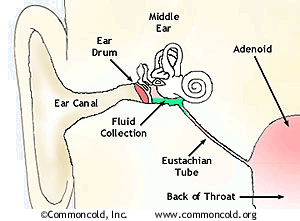Fluid Behind the Ears


Ear infections occur in a space behind the eardrum called the middle
ear. The Eustachian tube connects your middle ear and the back of your nose. Ear
infections occur because the kids get full of snot, that tube that connects the
middle ear space and the back of the throat/nose gets clogged and then we get a
middle ear space filled with pus.
We don't treat any other pus filled spaces with antibiotics. We lance boils, pop
zits, drain abscesses... so when kids get ear infections, I should be lancing
the pus. Yup, sticking a needle across the eardrum and getting the pus out of
there, right in the office. Hah! Never going to learn how, although there are
plenty of docs that do that.
The reason we drain pus is that antibiotics work through the bloodstream and
there isn't much blood that goes to the pus. Antibiotics probably help with
clearing the snot, but probably don't help much with the infection, It's one of
the reasons that the Europeans don't treat ear infections with antibiotics.
So, we have pus behind the drum and really no way to treat it, except
antibiotics that maybe get in there, maybe not.
We prescribe antibiotics for 10 days, which is probably
way too long and
then see you back in a month to make sure everything looks better. I would
change an antibiotic if the boogers didn't get better, the fever never went away
or the child stayed crabby.
What's left behind when you don't lance a boil is something called an effusion.
We tell you it's "fluid behind the ears." That effusion doesn't contain
bacteria, can be really, really annoying to the kids (so they'll probably still
pull at their ears like we would if we were on an airplane and couldn't pop our
ears) and does not get better with antibiotics. One of the things I hear a lot
is "this is his 5th ear infection in the last 4 weeks and we've tried 3
different antibiotics and nothing works." That scenario is more likely one
infection and an effusion and those extra courses of antibiotics are unnecessary
unless new symptoms develop.
The effusion can be present for up to 3 months or more and we can give
antibiotic after antibiotic and it won't make a difference. The antibiotic won't
help an asymptomatic effusion. If your child takes the antibiotics and then gets
snotty again, a new fever develops or they are newly crabby, then maybe it's an
new infection that needs antibiotics, otherwise it's an annoying effusion.
We should be seeing you back, if your child is happy, less snotty and has no
fever, in about a month after the infection was diagnosed, since the effusion
that's left over behind the eardrum (because I didn't lance the drum) lasts for
months in some kids. If it goes on for 3 months, then I send you to my favorite
ear, nose and throat doc, and they, under the humane
condition of general anesthesia and with much more skill than I will ever have,
puts in tubes to drain the effusion.
Sometimes the eardrum ruptures. That's cool... Mother Nature doing what I was
too chicken to do. In that case, clean the pus as it comes out and make a
recheck appointment in one month. The drum usually heals up without a problem
and your child usually feels bunches better.

